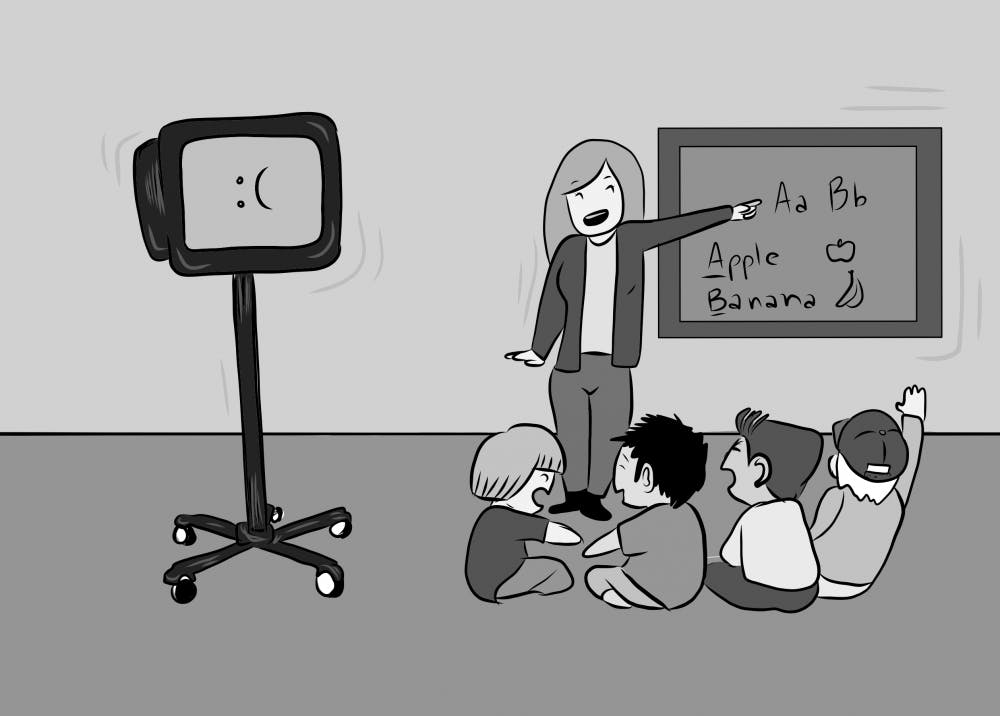The increasing amount of information available at our fingertips through technology has changed the education process drastically. As technology is incorporated into the classroom, it will modify education, but one thing will remain constant: teachers.
For 2017, Best Colleges ranked ASU Online No. 2 for online colleges. ASU Online offers more than 150 degree programs for non-traditional students. However, the creation of ASU Online has arguably led to more on-campus students taking online classes when similar in-person classes are available to them.
According to a Columbia University study, students do not choose to take online courses for "a superior learning experience" and instead most students take what they consider “easy” online classes.
Online teachers put an abundance of time and work into their courses, just as professors who teach face-to-face classes do, but they have to work harder to create a classroom environment similar to a live class and push students to perform active learning.
“There is actually a lot more that goes into designing, structuring and making everything very clear and laid out in the online class compared to the face-to-face class. You can have more flexibility in the face-to face classroom to modify things on the fly and adapt to your students’ immediate responses as you're lecturing or as you're presenting materials,” said Molly Ott, assistant professor in the Mary Lou Fulton Teachers College and coordinator of the Higher and Postsecondary Education program.
While there is nothing wrong with online classes or the education system trying to adapt to the digital age, these classes do not allow for all aspects of learning to occur.
Students in online classes don't interact with professors like they do in live classes. In an online class, emails and discussion board posts replace personal interactions with a professor.
“There is an informality. I don’t think it's just a dynamic of online education, I think it has to do with social media and online communication. I will have students call me by my first name, which I don’t particularly mind, but sometimes it's very informal,” said Mary Jane Parmentier, a clinical associate professor in the School for the Future of Innovation in Society.
In a live class, students can stop their professor and ask questions about challenging material. Additionally, professors share their real-world industry stories in live classes, which exposes students to what they can expect in the future. In-person classes also allow students to create professional relationships with their professors.
Ott said research shows the more students interact with their professors, the more they learn and are satisfied with their college experience.
The switch to online programs from face-to-face classes has raised a conversation about whether teachers will always be vital to the educational experience. However, it is hard to imagine schools without teachers.
Imagine teachers being replaced by machines, and your online class being run by an automated system. This would make education less personal and would strip students of certain skill sets they need for their future.
“I can’t image that a robot or a computer could ever replicate that kind of idiosyncratic and sort of special kinds of interactions that take place between instructors and students in regards to feedback, and pushing learning and having conversations and helping students to make sense of course content,” Ott said.
Teachers will always serve as an integral part of student development, but their role will change as technology does. Instead of moving toward an education system that is solely online, we should incorporate this technology into the classroom and value the educators we already have.
Online classrooms and teaching have helped teachers improve their live classrooms, by teaching students to apply the knowledge available to them.
Penelope Moon, director of online graduate programs for the School of Historical, Philosophical and Religious Studies and a clinical associate professor of history, said there has been a switch in pedagogical trends used today.
“It used to be that most classes were taught by a sage on the stage, a really smart person standing up at a podium and just kind of spouting knowledge, and hoping that it sunk in with students. But more and more research suggests that students actually learn better when they have more control over what’s going on in the classroom and they're kind of directing their learning, it's called active learning,” Moon said.
Reach the columnist at afsuthe1@asu.edu or follow @a_sutherland10 on Twitter.
Editor’s note: The opinions presented in this column are the author’s and do not imply any endorsement from The State Press or its editors.
Want to join the conversation? Send an email to opiniondesk.statepress@gmail.com. Keep letters under 500 words and be sure to include your university affiliation. Anonymity will not be granted.
Like The State Press on Facebook and follow @statepress on Twitter.




